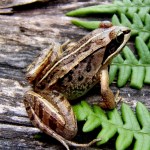This most asked question about frogs and toads is not easy to answer.
The following differences are generally true, but there are usually exceptions.
Legs - Frogs have long legs for leaping; Toads have short legs and walk or hop. That effects how they avoid predators and capture food. Frogs can leap away from danger, while toads depend more on hiding, camouflage, or skin toxins.
Teeth - Toads have no teeth; most frogs have minor upper teeth. Both frogs and toads swallow their food whole and have no way to chew their food. The teeth in frogs are used to prevent the prey from escaping.
Skin - Frogs tend to have smooth, slippery skin (good for streamlined swimming); Toads have dry,warty skin.
Toxins - Both frogs and toads have skins that will release nasty toxins to prevent predators from eating them, but toads have an additional pair of Parotoid glands located behind their eyes that are full of toxins.
Tongues - Frogs have long tongues that will occasionally miss their mark, but their leaping abilities create more eating opportunities. Toads have shorter tongues so the prey needs to be closer, but they never miss.
Bodies - Frogs tend to be light and slim (so they can jump farther). Toads tend to be chubby little critters.
Eyes - Frogs eyes tend to be able to see forward, backward, up and down. Toads eyes face more forward.
Eggs - Frogs lay their eggs singly, in clumps, or in floating films. Toads lay their eggs in long strands.
It is not wrong to think of toads as frogs with unique characteristics. Frogs and toads are both amphibians in the order Anura - meaning “tailless.”
Caution - Since frogs and toads both have skins that can secrete toxic substances, it is important that you wash your hands thoroughly after handling one and avoid contact with your eyes, nose, or mouth.


